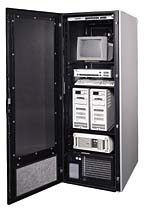This has created challenges for many schools, especially when it comes to finding a suitable temperature-controlled environment for computer systems. Often, available spaces within the school are small, poorly ventilated, or subject to extreme temperature changes. Others are not secure enough to house a computer network.
But Liebert believes it has solved this problem with its Foundation Mini Computer Room (MCR).

A Small Solution
The Foundation Mini Computer Room isn't really a room, but, according to Liebert, it has everything a proper computer room would need. Phil Aldag, Foundation product manager at Liebert, calls it "the computer room in a box."The unit stands at a little over six feet tall, is two feet wide, and about three feet deep. Computer equipment and network systems are safely placed within the unit, which is covered with a glass door.
A load-sized, computer-grade air conditioner is then located at either the top or bottom of the unit to cool the equipment. The MCR also has a backup cooling system in case of emergencies, as well as a SiteNet Integrator, which monitors the computer systems to make sure that they are getting the cooling they need and to make sure no one is tampering with them.
Aldag said that MCR is not new. It was designed over 10 years ago as an alternative to data centers. The unit allows for networking systems to be placed anywhere, instead of having to be relegated to one climate-controlled room.
Word about the MCR got out and piqued the interest of schools and educational facilities.
"Early on, many school systems were finding the product and seeing it as a perfect fit for their needs," said Aldag.
Another factor driving interest in the MCR is the fact that many schools are decentralizing their computer network systems. Instead of housing the system that connects several schools or several campuses together, many educational institutions have opted to house individual computer networks in various spots in each building. These network systems can involve very costly pieces of equipment that are integral to the schools' programs. But limited space and climate problems made decentralizing a challenge.
For example, the school district in Grand Rapids, Mich., wanted to decentralize its computer network to avoid the possibility of a single incident taking down the entire network. To do this, computer systems were assigned to six separate facilities.
"We had to make sure our equipment had the same level of protection when we decentralized as it did in a central location," said Craig Ghareeb, network and systems administrator for the school district. "We used Foundation to act as six computer rooms, one at each hub. It was the only product that fit the bill."
An Easy Installation
The MCR units are designed for easy installation, according to Aldag."We wanted customers to be able to roll it off the skid, plug it in, and be ready to go," he said.
If installation is so easy, where does the contractor come in with the MCR system?
Aldag said that contractors who have maintenance agreements with schools can check out the MCR units during regular visits. The MCR is also another piece of equipment that contractors can recommend and offer to school officials who are having difficulty finding ways to properly cool their computer equipment.
And Liebert believes that its Foundation MCR is beneficial in several other ways. Not only can the unit send an alarm when an individual is trying to tamper with computer systems, it also comes with backup cooling. With power outages looming as a top concern for those at many institutions that rely on their network systems, the MCR can keep equipment cool if there is a loss of power.
Aldag said that the school market has been the most responsive to the Foundation MCR, but the system can be used in a number of other applications, including banks and office buildings.
Publication date: 11/03/2003




